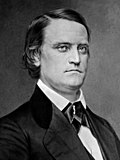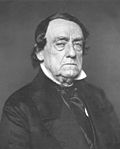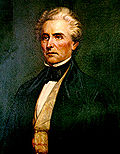| 1856 presidential election | |
  Nominees Buchanan and Breckinridge | |
| Convention | |
|---|---|
| Date(s) | June 2–6, 1856 |
| City | Cincinnati, Ohio |
| Venue | Smith and Nixon's Hall |
| Candidates | |
| Presidential nominee | James Buchanan of Pennsylvania |
| Vice-presidential nominee | John C. Breckinridge of Kentucky |
The 1856 Democratic National Convention was a presidential nominating convention that met from June 2 to June 6 in Cincinnati, Ohio. It was held to nominate the Democratic Party's candidates for president and vice president in the 1856 election. The convention selected former Secretary of State James Buchanan of Pennsylvania for president and former Representative John C. Breckinridge of Kentucky for vice president.
Contents
- Background
- Proceedings
- Presidential nomination
- Presidential candidates
- Vice Presidential nomination
- Vice Presidential candidates
- Declined
- Aftermath
- See also
- References
- Works cited
- External links
Incumbent Democratic President Franklin Pierce's standing with the public had been badly damaged by "Bleeding Kansas," the civil strife in Kansas Territory over slavery. Many dissatisfied Democrats lined up behind Buchanan, who had served as Pierce's ambassador to Britain and thus had avoided the controversy over Bleeding Kansas, while a smaller group of Democrats supported Senator Stephen A. Douglas of Illinois. Buchanan led on the first ballot and slowly grew his support on subsequent ballots, leading Pierce to instruct his delegates to back Douglas. Douglas agreed to withdraw his name after receiving assurances that Buchanan would not seek re-election in 1860, allowing Buchanan to clinch the nomination on the seventeenth ballot. Pierce became the first and only elected president who was an active candidate for reelection to be denied his party's nomination for a second term.
Eleven candidates received votes on the first vice presidential ballot, with Congressman John A. Quitman winning a plurality of the vote. The delegates lined up unanimously behind Breckinridge on the second ballot, giving him the vice presidential nomination. The Democratic ticket went on to win the 1856 election, defeating the Republican ticket of John C. Frémont and William L. Dayton and the American Party ticket of Millard Fillmore and Andrew J. Donelson.





































